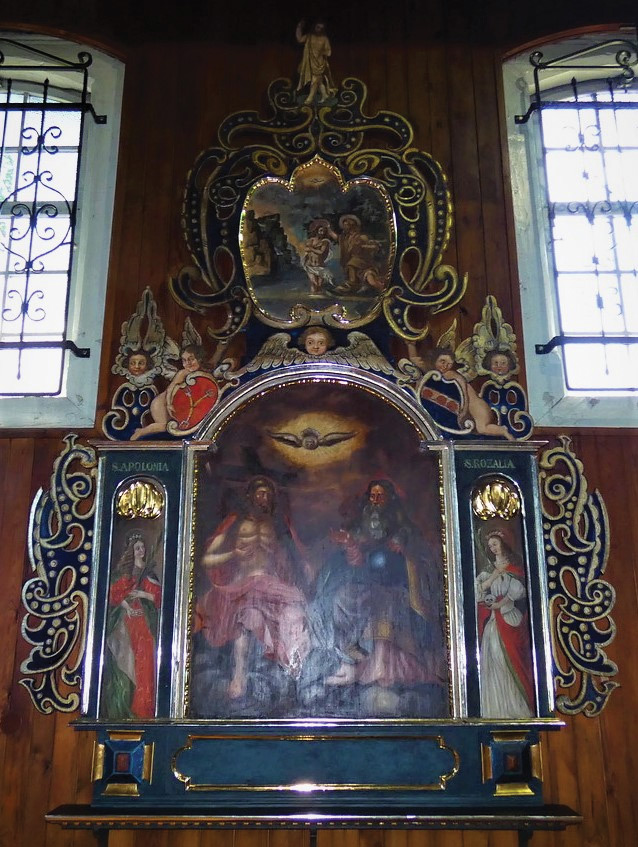Wooden monuments
Holy benefactresses
A meticulously decorated 18th century side altar dedicated to Holy Trinity is very interesting. The altarpiece (also known as a retable, i.e. painted or carved “screen” of the altar) was beautifully decorated with openworks by skilled woodcarvers.
While looking at the piece, the effect of work of the craftsmen from the turn of Mannerism and Baroque, it is worth to appreciate their creative enthusiasm.
- St. Rosalia – the hermit from the 12th century who lived in a cave in Sicily is an effective guardian against the plague. It the picture she is presented with a skull because during a plague outbreak in Palermo, the saint appeared in the dream of a young village girl and ordered to move her remains from the cave to the city. When this was done, the plague miraculously ceased.
- The Christ Resurrected
- The scene of baptizm of Christ.
- St. Apollonia with a palm tree twig, in the open right hand she is showing her own teeth. She is the patron saint of dentists and she also gives courage to patients before the visit to the dentist.Painting of the Holy Trinity is put on the main altarpiece: the Son of God (on the left) and God the Father (on the right), and the Holy Spirit above Them in the shape of a dove.


According to the tradition, in the eve of St. Apollonia’s day (9th February) praises were sung to her and the saint was even asked to ‘save from toothache’. This prayer from the 18th century includes a request for relief of toothache:
‘When toothache occurs so much that the head hurts it is not easy for the barber to pull out, o the martyr whose teeth were knocked out relief the pain, beget my teeth are not gnashed in hell’.
Those who have ears, listen
The colours are the thing which attracts attention in this late Renaissance pulpit. Images of the four Evangelists are painted on it. Each of the saints has been depicted with his attribute (an object or a figure). Below the images of the saints, their names are put as well.

The attributes of the Evangelists refer to the opening scenes of the Gospels they wrote:
- St. Mark – a lion (the work of St. John the Baptist, the voice of one calling in the wilderness)
- St. Matthew – a man (the pedigree of Jesus Christ)
- St. Luke – an ox (a sacrifice that Zechariah made to God when he learnt that his prayers were heard and his wife Elisabeth would give a birth to his son, John the Baptist)
- St. John – an eagle (‘In the beginning was the Word, and the Word was with God, and the Word was God’. It is the most sublime, ‘lofty’ Gospel which describes miracles of the Son of God).
Indulgences
15 sierpnia (Najświętszej Maryi Panny Wniebowziętej)





